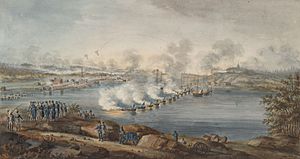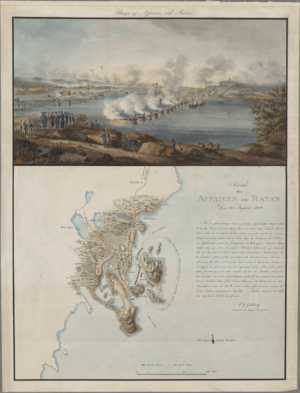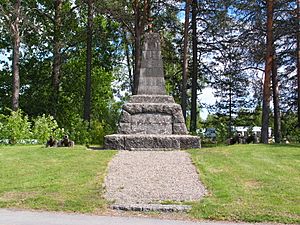Battle of Ratan facts for kids
The Battle of Ratan was the last battle fought on Swedish land during the Finnish War. This war was between Sweden and Russia from 1808 to 1809. The battle happened on August 20, 1809, just one day after the Battle of Sävar.
Russia had already taken Finland from Sweden. They had a small army in northern Sweden. The Swedes wanted to push them out. They planned a big attack from both land and sea. But the Russian army moved faster. They defeated the Swedish troops at Sävar on August 19. The next day, at Ratan, Russian soldiers attacked Swedish riflemen. The Swedes were pushed back to their ships and started to leave. Luckily, cannons from Swedish warships helped keep the Russians away. Soon after, peace talks began.
Quick facts for kids Battle of Ratan |
|||||||
|---|---|---|---|---|---|---|---|
| Part of the Finnish War | |||||||
 |
|||||||
|
|||||||
| Belligerents | |||||||
| Commanders and leaders | |||||||
| Strength | |||||||
| 5,400 | 3,000 | ||||||
| Casualties and losses | |||||||
|
150 killed, wounded or captured | ||||||
Contents
Why the Battle Happened
The Finnish War was a big conflict. Russia wanted to take Finland from Sweden. By 1809, Russian forces had captured the city of Umeå. They had pushed the Swedish army, led by Johan August Sandels, south.
Sweden's Plan
Tsar Alexander I of Russia demanded that Sweden give up all of Finland. Sweden wanted a better position for peace talks. So, the Swedish army planned a clever attack. They would land troops north of Umeå. These troops would attack the Russian army from behind. At the same time, a Swedish army of 3,400 men, led by Fabian Wrede, would attack from the front.
Choosing a Commander
Lieutenant-General Gustav Wachtmeister was chosen to lead the sea attack. He was an experienced soldier. He had fought in wars before, including the Gustav III's Russian War and the Pomeranian War.
The Sea Journey
The Swedish navy and the Royal Navy (from Britain) controlled the sea. This meant there was no danger from the Russian fleet. The Swedish ships left Stockholm on August 8. They sailed north towards Ratan, which was about 45 kilometers (28 miles) north of Umeå. To avoid being seen by the Russians in Umeå, they sailed east of Holmön island. The ships arrived at Ratan on August 16. The attack was planned for August 19.
The Swedish force that sailed included:
- Two large warships (called Adolf Fredrik and Försiktigheten)
- One frigate (a type of warship) called Jarramas
- 44 smaller gunboats and bomb vessels
- 6 galleys (ships moved by oars)
- 20 to 40 ships to carry troops
- About 6,800 soldiers
Russian Response
On August 17, the Swedish soldiers got off their ships at Ratan. Later that day, they defeated a small group of Russian soldiers in Djäkneboda. The Russian commander, Lieutenant-General Nikolay Mikhailovich Kamensky, was marching south. When he heard about the Swedish ships, he quickly turned his army around. He marched north to face Wachtmeister's army before Wrede's army could arrive.
The Battle of Sävar
The Swedish force under Wachtmeister was stopped at Sävar. This village was about 20 kilometers (12 miles) north of Umeå. The Russians attacked Wachtmeister's army at Sävar at 7:30 AM on August 19. The Russian army quickly took control of the high ground. The Swedes then attacked the Russians uphill. A tough battle took place. Even though the Swedes fought well, Wachtmeister told his forces to go back to Ratan. The Battle of Sävar ended at 3:00 PM.
The Battle of Sävar was a Russian victory. However, the Russian army was too tired and had too many injured soldiers. They couldn't face Wrede's army, which was coming from the south. At Sävar, Sweden lost 396 soldiers killed and about 450 wounded. The Russians lost about 600 killed and about 1000 wounded.
The Battle of Ratan
After the Battle of Sävar, the Swedish army went back to the village of Ratan. They quickly got ready for another fight. On August 20, Kamensky ordered his Russian army to attack the Swedes. This attack was meant to slow the Swedes down. It would give the Russian supply wagons time to retreat north.
Artillery Support
This time, Sweden had help from their artillery. They had cannons on the ground and also on their ships. In total, the Swedish army had about 100 cannons ready to fire. The cannon fire destroyed much of the village and the area around it.
During the Battle of Ratan, Wachtmeister was able to hold off Kamensky. This was thanks to the strong support from the Swedish ships. After the battle, Kamensky's army retreated north towards Piteå. Soon after, Swedish troops entered Umeå.
The Battle of Ratan had fewer casualties than Sävar. Sweden lost 150 men (26 killed, 122 wounded, and 2 captured). Russia also lost about 150 men (killed, wounded, or captured).
Aftermath
The Russians managed to take Ratan. But they had to leave it because of the Swedish ships' cannon fire. The Russian cannonballs could not reach the Swedish fleet. A line of Russian jägers (light infantry) stood in the woods. The Swedish army on land was not defeated because of the fleet. They got onto their ships safely and sailed away.
The Russian army could not stay. An enemy army was coming from the south, and they had just lost many soldiers. So, they retreated north after the battle. This made things easier for the Swedish army. Many people believe that the battles at Sävar and Ratan helped Sweden get a better deal in the peace talks with Russia.
Peace Negotiations
At first, Tsar Alexander of Russia wanted a lot of land. He demanded all of Österland (Finland), Åland islands, and parts of northern Sweden. He wanted the border to be drawn at the Kalix River. But the fighting at Sävar and Ratan helped Sweden. The border was moved further north to the Tornio and Muonio rivers in the peace agreement.
Having the border further north turned out to be very good for Sweden later on. Big amounts of iron ore were found in these northern areas.



